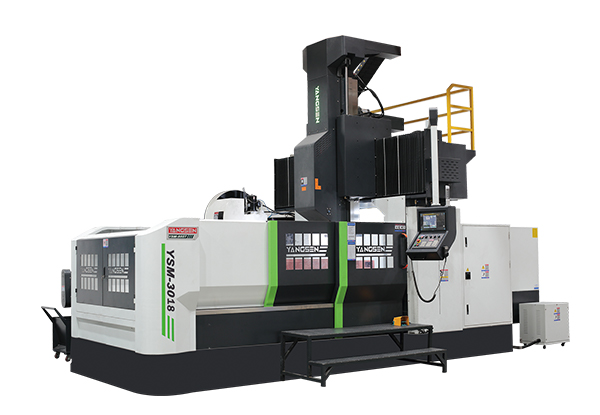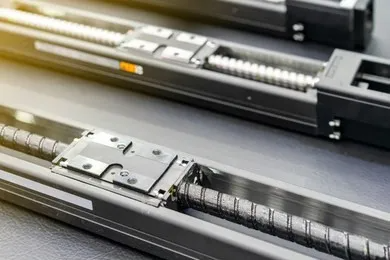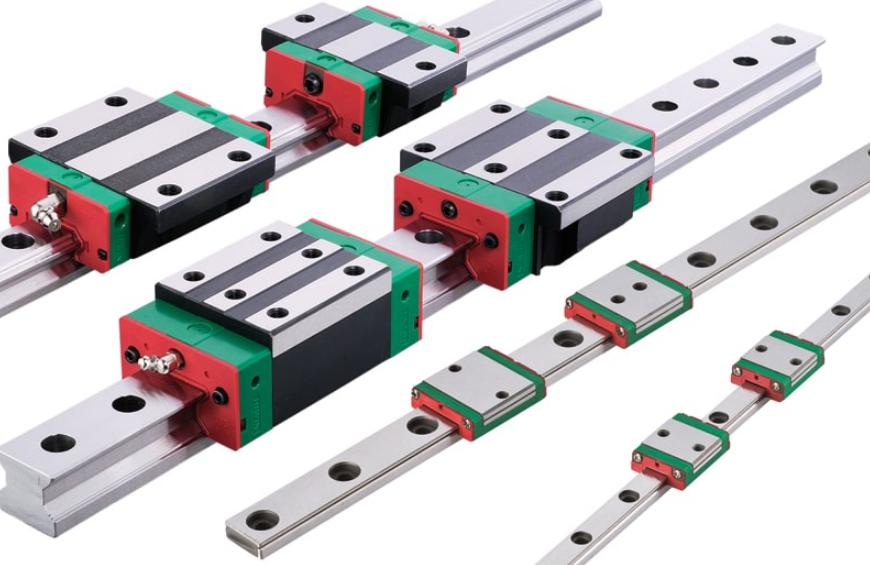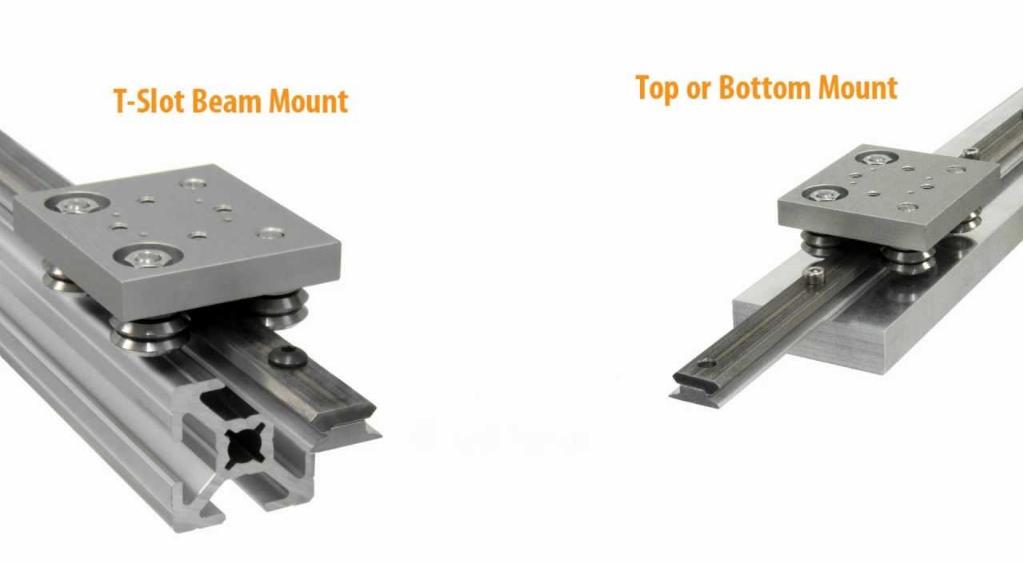Diving into the world of CNC machines brings you to CNC linear rail types. Their role is key in precise machine control. In this guide, you'll learn all about them. Let's explore together.

Numerical instructions control CNC machines. These precise devices create parts with strict tolerances. The CNC machine, using 3 axes, can cut metal, plastic, or wood. Each CNC component, like the spindle or bed, has a crucial role. Linear rails also hold key importance.
Linear rails support movement in CNC machines. They guide the cutting tool along the correct path. With different rail types, CNC machines achieve various cutting actions. Hence, your choice of rail directly affects precision and efficiency in CNC operations.
Linear rails guide CNC machines to move parts in a straight line. Working with specific tolerances, linear rails control motion along the X, Y, and Z axes. They employ ball bearings for smooth operation.
• Precision Control: CNC linear rail types work with minute precision, enhancing machine accuracy to a ten-thousandth of an inch. Your CNC machine needs this for high-quality production.
• Speed Enhancement: Linear rails allow fast motion. With speeds up to 5m/s, productivity soars. Your machine completes tasks quicker.
• Load Distribution: Linear rails evenly distribute loads, minimizing stress on individual components. This load balance is vital for producing high-quality auto parts.
• Noise Reduction: Less friction means less noise. Linear rails with ball bearing designs offer quiet operation. Silent machines mean a more comfortable work environment.
• Friction Minimization: Linear rails reduce friction. Lower friction ensures more efficient motion, saving energy and boosting machine lifespan.
• Machine Longevity: Less wear and tear extend machine life. Linear rails contribute to this by reducing friction and balancing loads. Your CNC machine's service life extends, saving money.
• Component Stability: Linear rails provide stability to moving parts. This prevents wobbling and maintains accuracy during high-speed operations.
• Production Efficiency: With increased speed, precision, and machine lifespan, linear rails boost overall production efficiency.
• Linear Motion: CNC machines, guided by linear rails, can move parts in a straight line. This motion is crucial for most CNC operations.
• Rotary Motion: Linear rails also facilitate a spinning motion. This is necessary for tasks like drilling or milling. A CNC drilling machine, for instance, relies on this rotary motion.
• Reciprocating Motion: This is a back-and-forth movement. Linear rails ensure smooth reciprocating motion, useful in operations like cutting.
• Oscillatory Motion: Some CNC operations require a swinging motion. Linear rails control this oscillatory movement for precision.
• Spiral Motion: When machining threads or helical gears, spiral motion is essential. Linear rails facilitate this complex movement.
• Irregular Motion: Certain tasks require irregular motion. Thanks to the precision control of linear rails, irregular motion can be achieved with accuracy.

• Roller Type: Famed for carrying high loads, roller types excel in metal-cutting tasks.
• Ball Type: With exceptional precision, ball types serve delicate applications in microelectronics.
• Miniature Type: Suited for tight spaces, miniature types shine in small machinery operations.
• Heavy-duty Type: Tough and strong, heavy-duty types bear heavy loads in large machinery.
• Crossed Roller: Offering superb precision, crossed rollers excel in precision-based operations.
• Radial Type: Unique in design, radial types enable flexible mounting in diverse machinery.
• Profiled Rails: Highly versatile, profiled rails integrate into a range of applications.
• Guide Rails: Essential for motion, guide rails ensure smooth movement in machines.
• Linear Shaft: Primarily for support, linear shafts sustain axial loads in machine functions.
• Load Capacity: Roller and heavy-duty types stand out in carrying substantial loads.
• Mounting Flexibility: Radial and profiled rails win for versatile mounting options.
• Durability: Heavy-duty types boast longer durability due to robust construction.
• Speed Handling: Ball types surpass others in handling high speeds efficiently.
• Cost: Miniature and ball types offer cost advantages due to simpler manufacturing.
• Maintenance: Guide rails require less maintenance owing to their simpler design.
• Lifespan: Heavy-duty types promise a longer lifespan thanks to their rugged structure.
• Precision: Crossed rollers and ball types provide unmatched precision in operations.
• Rigidity: Roller and heavy-duty types offer superior rigidity, supporting heavy-duty applications.
• Bearing Style: Linear rails employ ball bearings. In contrast, V-slots use delrin wheels.
• Load Handling: CNC linear rail types withstand heavier loads due to robust construction.
• Rail Material: High-quality steel forms linear rails, V-slots rely on anodized aluminum.
• Price: Although more costly, linear rails offer increased longevity and precision. V-slots provide a budget-friendly option.
• Ease of Assembly: V-slots win here, with fewer components for installation.
• Durability: Linear rails, with hardened steel construction, possess superior durability.
• Precision: Exceptional accuracy characterizes linear rails, offering repeatability within microns.
• Noise Level: Linear rails produce less noise than V-slots during operation.
• Maintenance: Regular cleaning and lubrication extend the life of linear rails, while V-slots need less upkeep.
• Load Support: Linear guide rails support high loads. The sturdy structure ensures optimal machine performance.
• Guided Motion: Linear rails provide smooth, straight motion. Precision in movement is a hallmark feature.
• Precision Alignment: By ensuring accurate alignment, linear rails enhance the quality of CNC machining processes.
• Speed: High-speed operation is possible due to the seamless movement of the ball bearings.
• Noise Reduction: Low friction reduces noise levels, making linear rails a quiet operation option.
• Installation Ease: With a straightforward design, installing linear rails is usually a simple task.
• Friction Resistance: Ball bearings reduce friction, thereby increasing the efficiency of machine operations.
• Longevity: With proper maintenance, linear rails can last for years, even under high-stress environments.
• Stability: Stable, unwavering motion is another benefit of linear rails, ensuring consistent machining results.

Unravel the complex world of Hiwin linear rails, a popular CNC Linear Rail type. Hiwin rails showcase robustness, versatility, and precision. With dimensions ranging from 7mm to 65mm, each rail integrates seamlessly into your projects.
• High Accuracy: Get precise movements. Hiwin rails boast of sub-micron precision.
• Long Lifespan: With proper care, Hiwin rails serve for many years.
• Load Capacity: Weight is no issue. Rails support loads up to 30,000 Newtons. This load capacity is ideal for heavy machinery like a horizontal boring machine.
• Smooth Movement: Experience frictionless motion due to the precision-ground raceways.
• Rigidity: With high tensile steel, Hiwin rails resist bending and deformation.
• Low Maintenance: Enjoy ease of use. Hiwin rails demand less upkeep.
• Stability: Hiwin rails offer steady and reliable operations.
• High Speeds: Boost productivity. Hiwin rails operate at high speeds up to 5 m/s.
• Milling Machines: Improve precision with Hiwin rails in CNC milling machine operations.
• Grinding Systems: Rails ensure accurate grinding, enhancing output quality.
• Packaging Machinery: Enhance speed and efficiency in packaging processes.
• Inspection Equipment: Achieve superior precision in inspection systems.
• Automation: Boost automation with high-speed, accurate movements.
• Robotics: Facilitate complex movements in robots.
• Medical Equipment: Enable precise movements in critical medical devices.
• CNC Machines: Elevate machining accuracy, enhancing product quality.
CNC linear rail tolerances highlight the permitted variance in the dimensions of a rail. Small deviations matter in precise tasks. Such variance affects the smoothness of rail movement and the end product's accuracy.
• Precision: High tolerances mean less precise movement. Your machine might move 0.02mm more than expected. That's a big deal in high-precision tasks.
• Speed: Tighter tolerances result in reduced speed. Friction increases due to closer contact between components.
• Efficiency: Greater tolerances can cause energy loss, affecting efficiency. For instance, energy might be wasted in overcoming extra friction.
• Noise Levels: Looser tolerances can lead to more noise. Parts might not fit snugly, causing rattling or squeaking.
• Lifespan: Optimal tolerances ensure longer lifespan. Less wear and tear occur on parts.
• Load Capacity: Higher tolerances might lower load capacity. Rails may not hold the weight as expected.
• Stability: Tolerances directly affect stability. Larger variances might cause unpredictable movements.
• Accuracy: CNC machining accuracy depends on strict tolerances. Each movement needs to follow the program to a T.
• Regular Inspections: Frequent checks identify issues early. Spotting wear and tear prevents larger problems.
• Cleaning: Dust and dirt build-up affect tolerances. Keeping rails clean ensures smoother operation.
• Lubrication: Regular lubrication reduces friction. This action aids in maintaining expected tolerances.
• Adjustment: Tolerances might need occasional adjustment. Over time, wear can alter initial settings.
• Load Checking: Regularly check load capacity. Excessive load might stretch rails, affecting tolerances.
• Temperature Monitoring: High temperatures can change metal properties. Always keep an eye on machine temperature.
• Replacement: Worn-out parts need timely replacement. Old parts might not adhere to the original tolerance specifications.
• Calibration: Regular calibration ensures machine works as expected. It's essential in maintaining desired CNC linear rail tolerances.
CNC machines utilize linear slide rails, essential for precision. Typically, slide rails handle loads up to 300kg. Designed for heavy-duty applications, their lifespan often exceeds 50,000 operational hours.
• Load Handling: Linear slide rails handle loads up to 300kg, outclassing many counterparts.
• Friction Level: With rolling friction, slide rails achieve lower friction levels.
• Precision: Aided by ball bearings, slide rails provide superior precision.
• Speed: Linear slide rails support speeds up to 5m/s, offering top performance.
• Noise: Operating quietly, slide rails produce noise levels under 70dB.
• Lifespan: Durable design ensures a lifespan exceeding 50,000 hours.
• Maintenance: Slide rails, self-lubricated, demand minimal upkeep.
• Cost: Despite higher upfront costs, slide rails' longevity provides cost benefits over time.
Guideways, another type of CNC linear rail, offer precision and efficiency. With 25µm accuracy and speeds over 5m/s, they're an industry standard.
• Precise Motion: With an accuracy level of 25µm, guideways ensure exact movements.
• Load Support: Able to bear loads up to 150kg, guideways provide robust support.
• Speed Enhancement: Guideways enable rapid operations, with speeds exceeding 5m/s.
• Durability: Crafted for longevity, guideways offer over 40,000 operational hours.
• Reduced Friction: Utilizing ball bearings, guideways achieve lower friction.
• Increased Efficiency: Higher speeds and precision boost machine efficiency.
• Low Noise: Guideways operate silently, with noise levels under 60dB.
• Design: Guideways, compact and lightweight, suit small CNC machines.
• Load Capacity: Though less than slide rails, guideways support loads up to 150kg.
• Speed: High-speed operations, with over 5m/s, are attainable with guideways.
• Precision: Guideways deliver impressive accuracy, at 25µm.
• Noise: Quiet operation is a key advantage of guideways.
• Durability: Guideways last over 40,000 hours, though less than slide rails.
• Maintenance: Ball bearings in guideways require regular lubrication.
• Cost: Affordable upfront, guideways have higher long-term maintenance costs.
• Regular Cleaning: Wipe down the linear rails daily to prevent dust build-up. A clean cloth and light detergent work best.
• Lubrication: Apply quality lubricant every 50 hours of use. Ensure even distribution.
• Load Adjustment: Too much pressure can cause wear and tear. Balance the load for optimal performance.
• Alignment Checking: Misalignment leads to reduced precision. Utilize an alignment tool every 100 hours.
• Component Replacement: Swap out worn parts promptly. Always keep a spare set for emergencies.
• Noise Monitoring: Excess noise may signal a problem. Periodically check the noise level for any irregularities.
• Precision Testing: Check the precision of CNC linear rail types after each maintenance cycle. A precision gauge can help here.
• Troubleshooting Guides: Follow manufacturer's guides for problem-solving. They offer tailored solutions to common issues.

• Precision: Higher precision in rail types equates to accurate machining results. This is especially vital in the semiconductor industry, where precision is key.
• Speed: CNC linear rail types ensure swift movements, maximizing efficiency.
• Load Capacity: Proper load capacity helps manage heavy workloads without stress.
• Durability: Durable rail types resist wear, guaranteeing longer machine lifespan.
• Maintenance: Simple maintenance procedures help avoid expensive repairs.
• Noise Reduction: Reduced noise enhances the working environment.
• Machine Lifespan: Appropriate linear rail types extend machine life.
• Cost-effectiveness: Efficient rail types save on energy, reducing operational costs.
• Load Rating: Higher load rating means the rail can support more weight.
• Material Type: The material influences durability and strength.
• Precision Level: Determines the accuracy of the CNC machine's movements.
• Speed Capacity: Higher speed capacity allows for faster machining.
• Noise Level: Lower noise levels result in quieter operation.
• Lifespan: Longer lifespan ensures value for investment.
• Maintenance Requirements: Fewer maintenance needs mean less downtime.
• Size Dimensions: The size affects compatibility with the CNC machine.
• Lubricant: A must for reducing friction and ensuring smooth operation.
• Cleaning Cloth: Handy for keeping rails dust and debris-free.
• Precision Gauge: Crucial for monitoring the accuracy of the rails.
• Alignment Tool: Useful for ensuring the rails are properly aligned.
• Load Meter: Helps in adjusting the workload on the rails.
• Screwdriver Set: Essential for tightening and loosening components.
• Replacement Parts: Keep on hand to quickly swap out worn parts.
• User Manual: Holds all necessary information for operating and troubleshooting the rails.
You've now explored the vast world of CNC linear rail types, from their various uses to the benefits they offer. To continue your learning journey and find high-quality CNC products, visit CNCYANGSEN. It's your next step to becoming a CNC expert.